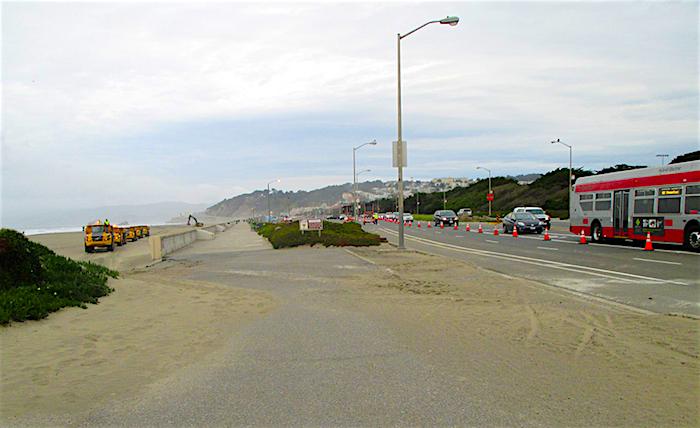
Sand trucking from north Ocean Beach, February 2016, and traffic impacts on the Great Highway/San Francisco Water Power Sewer
The San Francisco Public Utilities Commission, in cooperation with the National Park Service, is leading a short-term effort to transport excess sand via dump truck from north Ocean Beach to two erosion hot spots at south Ocean Beach. The work, performed weekdays from 7 a.m. to 5 p.m., is expected to last through December.
This year's efforts include the following components:
- Sand Backpass: Excavate approximately 70,000 cubic yards of sand from north Ocean Beach and place it in two erosion hot spots at south Ocean Beach, south of Sloat Boulevard.
- Wind-Erosion Control Measures: Natural brush fencing and/or other measures will be installed to reduce windblown sand from being transported onto the parking lots and Great Highway south of Sloat Boulevard.
Southbound traffic on the Great Highway will be detoured to Sunset Boulevard between Lincoln Way and Sloat Boulevard. Northbound traffic and Muni bus stops in the same stretch will remain unaffected; northbound traffic will experience a lane reduction between Highway 35 (Skyline Blvd) and Sloat Boulevard.
To protect public safety, access to the beach will be limited in certain areas when work is underway. Parking areas at the south end of the O’Shaughnessy Seawall and the overlook parking areas south of Sloat Boulevard will not be available during construction.
The dramatic shoreline changes along Ocean Beach are a result of both natural and human-caused factors, including sea level rise related to climate change, a Park Service release said.
In general, north Ocean Beach has been widening and accumulating sand while south Ocean Beach (i.e. south of Sloat Boulevard) has been experiencing loss of beach through erosion. The accumulation of sand impedes beach visitor access by filling in the stairwells and promenade and increases sand maintenance costs and efforts for the City of San Francisco and the National Park Service.
As part of a comprehensive effort, the San Francisco Public Utilities Commission developed short-term coastal protection measures that were authorized by the California Coastal Commission for six years (2015-2021).
These measures will continue until a long-term coastal management strategy, currently under development, is complete. The long-term coastal protection measures will include strategies developed in the Ocean Beach Master Plan, which include managed retreat, beach nourishment, and structural protection through adaptive management.
One option being considered for the long-term plan proposes removal of existing coastal armoring and installation of a subsurface, low-profile structure that would protect vulnerable segments of critical wastewater infrastructure south of Sloat Boulevard. The design, environmental review, and permitting of the long-term strategy is expected to take until 2021 to complete.



Add comment